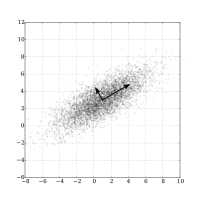
Photo from wikipedia
MOTIVATION As a rising research topic, brain imaging genetics aims to investigate the potential genetic architecture of both brain structure and function. It should be noted that in the brain,… Click to show full abstract
MOTIVATION As a rising research topic, brain imaging genetics aims to investigate the potential genetic architecture of both brain structure and function. It should be noted that in the brain, not all variations are deservedly caused by genetic effect, and it's generally unknown which imaging phenotypes are promising for genetic analysis. RESULTS In this work, genetic variants (i.e., the single nucleotide polymorphism, SNP) can be correlated with brain networks (i.e., quantitative trait, QT), so that the connectome (including the brain regions and connectivity features) of functional brain networks from the functional magnetic resonance imaging (fMRI) data is identified. Specifically, a connection matrix is firstly constructed, whose upper triangle elements are selected to be connectivity features. Then, the PageRank algorithm is exploited for estimating the importance of different brain regions as the brain region features. Finally, a deep self-reconstruction sparse canonical correlation analysis (DS-SCCA) method is developed for the identification of genetic associations with functional connectivity phenotypic markers. This approach is a regularized, deep extension, scalable multi-SNP-multi-QT method, which is well-suited for applying imaging genetic association analysis to the Alzheimer's Disease Neuroimaging Initiative (ADNI) datasets. It is further optimized by adopting a parametric approach, augmented Lagrange, and stochastic gradient descent. Extensive experiments are provided to validate that the DS-SCCA approach realizes strong associations and discovers functional connectivity and brain region phenotypic biomarkers to guide disease interpretation. AVAILABILITY The Matlab code is available at https://github.com/meimeiling/DS-SCCA/tree/main.
Journal Title: Bioinformatics
Year Published: 2022
Link to full text (if available)
Share on Social Media: Sign Up to like & get
recommendations!